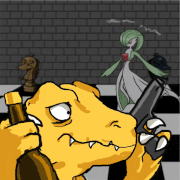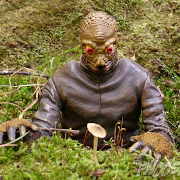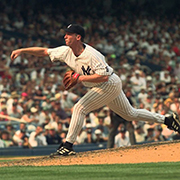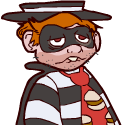|
Have a hollow outer shell of one color, hollow inner shell of another, and use normal epoxy/resin to stick them together and fill in between with color and/or swirls.
|
|
|
|

|
| # ? May 28, 2024 14:24 |
|
Zorro KingOfEngland posted:I have had something like this happen when I was removing supports prior to completely post-curing. The way I've had it described to me is that the supports help keep the shape of the model as it's post-curing, and by removing them early you're allowing the material to cure in weird ways like that. Thanks to you and everyone else who offered some advice. Unfortunately the arrow itself was completely unsupported so there was nothing I could do there (other than adding supports I guess), but what I ended up doing was significantly changing up how I cleaned this particular model. Normally I soak prints in IPA for a while first to get 95% of the resin off of them, then do a clean IPA bath but in this case I skipped the soak step and just went for 10 mins in the clean IPA. Then I washed the print in super cold water to try and minimize any resin weirdness. Final result is much better:  BMan posted:I'd like to point out that this bow's limbs are not bent as they should be, making the string comically long, also the draw length is way too long, the artist should fix this
|
|
|
|
Deviant posted:Could I just add fine iridescent glitter, or would that gently caress up the print (and potentially the vat)? The short answer is "no" the long answer is "well, kinda" I'm loving around with glitter right now, and there's a fine balance of getting it to glitter and having the prints succeed. All the mica glitter I'm using is, I guess? heavier than the resin, so it slowly sinks to the bottom of the vat, and once parts of the print get a bit too thick, they just pop off the supports, no matter how many I add (This is a working theory right now. I just did 6 identical prints with no issues, added more glitter, 3 failures deep) Fortunately this means that I can just kind of dredge the glitter from the bottom of the vat without having to completely toss the whole batch Or if I pout the vat out most of the glitter stays behind and I can just clean that out separately and put the glitter back in Billie Ruben and Zach Friedman seem to get really good results with glitter mica that I just can't quite replicate Other mica powder seems to work just fine though, I've been running off UV-glow prints with no issue
|
|
|
|
I've asked this question before and I think it was answered but I can't remember the answer... is there any particular advantage/disadvantage to those triangular 3D printers compared to the more traditional X/Y/Z ones?
|
|
|
|
Delta printers can be very fast. All the drive motors are fixed on the frame, and if you use a bowden extruder, the end effector only has to carry the hotend. So it's very light and can fly around at high speed. Here is an industrial delta robot using the same sort of kinematics: https://www.youtube.com/watch?v=vtAEIKJLHGw Deltas are also well suited to printing tall thin parts, because the bed never moves and they can be made arbitrarily tall just by extending the three uprights and belts/wiring. They work perfectly well but the new hotness right now is CoreXY, which has the same advantages of a delta design (no heavy motors on the moving parts) but a more useful envelope shape and arguably is a little more rigid. Sagebrush fucked around with this message at 18:29 on Nov 9, 2021 |
|
|
|
goddamnedtwisto posted:I've asked this question before and I think it was answered but I can't remember the answer... is there any particular advantage/disadvantage to those triangular 3D printers compared to the more traditional X/Y/Z ones? Delta printers can be faster than cartesian ones, but their build volume is round and not as tall as the printer (the arms that go to the print head always take some space). Jaded Burnout posted:You folks have helped me before, but I'm a little stuck with parts losing bed adhesion again. With bed adhesion issues I wouldn't leave the printer unattended. Generally it's not a great idea anyway even though here's thermal runaway protection and other things you can do to try to monitor your prints automatically (like the spaghetti detective). I don't feel comfortable leaving a print running for more than a few hours if I'm away. The bed adhesion issues could be a lot of things from the bed temperature to the material to the bed itself. Ideally PEI won't release the model until it's done and you flex it. Since yours is letting go early and you've tried glue stick, I'd definitely give the textured surface a shot. I know you said you're using PLA but they're not all created equal and there can be minor differences between batches and colors from the same manufacturer. One thing that gets brought up here from time to time is that white colored filament often has titanium dioxide in it for the color and some brands benefit from a slightly higher temperature. Also, with the season getting cooler in the northern hemisphere your printer may be in a cooler area and it's possible your bed temp could use a bump up. I don't know what you keep it at for PLA but 50C is common and I sometimes run 60C if it's cooler. Likewise if there's a vent from your heating near the printer it could be blowing air past it and cooling it unintentionally. Since there's a lot of variables and you haven't had consistent results I'd change things until you do have good results, and definitely don't leave it alone while you're away until you feel it's reliable enough to do so. It's just not worth the potential damage from cleaning a big blob of plastic off your hotend or the unlikely but not impossible chance of a fire.
|
|
|
|
goddamnedtwisto posted:I've asked this question before and I think it was answered but I can't remember the answer... is there any particular advantage/disadvantage to those triangular 3D printers compared to the more traditional X/Y/Z ones? Those triangular 3d printers were the traditional design before Cartesian machines became available to hobbyists, I think? It wasn't by a margin of very much time, either, but I thought Delta designs came out of Reprap first, then came your Mendel/cartesian designs. But yeah, Delta 3d printers are basically just fun to watch because they can move at ridiculously fast speeds compared to most cartesian machines that aren't at Voron 2.4 levels of Core X/Y rigidity (but really, any stationary bed design tends to have really fast X/Y movement capabilities vs. any moving bed design). EDIT: If you really want to have some fun, look up the Polar and SCARA 3d printer designs out there. Imagine 3d printing on Polar machines and trying to troubleshoot square objects being out of square or straight lines not printing straight.
|
|
|
|
Rexxed posted:With bed adhesion issues I wouldn't leave the printer unattended. Generally it's not a great idea anyway even though here's thermal runaway protection and other things you can do to try to monitor your prints automatically (like the spaghetti detective). I don't feel comfortable leaving a print running for more than a few hours if I'm away. OK thanks. The standard Prusa setting for PLA (it's their PLA, but not "prusament" PLA) is 60ļC on the bed, IIRC. I can bump it up? And I'll try the textured plate. The room doesn't have ventilated heating, but I've had a small radiator on nearby to keep the room warm since it's quite cold otherwise. Not enough to affect the airflow, I hope. The room will have been at a stable warm temperature for several hours at the point where it let go on this print. Speaking of cleaning plastic off the nozzle, how the heck are you meant to do it? The print head seems to sit solidly wherever it last was which makes access awkward, but even then the PLA is very firmly bonded to the metal nozzle. Also, when I want to get it to grip more, do I clean the plate more, or less?
|
|
|
|
I used to work in a print room with 3 bowden delta printers and they were nothing but goddamn problems Also, if i have to leave my printer unattended, i suggest a webcam you can monitor remotely, and a smart plug. if i see i'm making spaghetti, i can just cut power.
|
|
|
|
Jaded Burnout posted:OK thanks. The standard Prusa setting for PLA (it's their PLA, but not "prusament" PLA) is 60ļC on the bed, IIRC. I can bump it up? And I'll try the textured plate. 60C should work fine. In my experience, the textured plate makes it harder for PLA to stick and was meant for printing PETG on it (which is really, really sticky and shouldn't be printed on a smooth PEI sheet). Jaded Burnout posted:Speaking of cleaning plastic off the nozzle, how the heck are you meant to do it? The print head seems to sit solidly wherever it last was which makes access awkward, but even then the PLA is very firmly bonded to the metal nozzle. Not sure if I'm misunderstanding, but you can press down on the dial and automatically bring up the manual Z axis movement menu, then turn it clockwise to raise it. You can also go into the Settings menu to move the X and Y axes (or just slowly push them by hand). Bringing the extruder to the top of the printer will make the nozzle easier to get to. Jaded Burnout posted:Also, when I want to get it to grip more, do I clean the plate more, or less? You want the bed to be immaculate at all times. You should clean the plate with a clean sponge and dish detergent. Scrub it thorougly and then rinse both sides until you don't see any suds. Give it some extra rinsing to make sure the soap is gone and then dry with clean paper towels. It's important you don't touch this directly with your hands or get anything oily on it (I use kitchen gloves that I only use to handle the sheet to do this entire part). A lot of problems with adhesion come from oils on the bed. Also can you post a picture of the bottom of your print with some good lighting? How does your first layer Z adjustment look? Your setup should get the print to stick no problem, so I don't think you need to add a gluestick or tape or a new sheet or anything. I think first layer adjustment or a dirty bed are the most common causes of adhesion failure. Something that helps get that last bit of adhesion is to preheat the bed and wait for about 5-10 minutes after the bed has reached temperature before you print. You gotta be careful to clean up the oozing out of the nozzle if you wait this long, though. You can also use some fine grit sand paper or acetone to refresh the smooth PEI sheet. Save this for when you've tried everything else and none of it worked.
|
|
|
|
Sagebrush posted:They work perfectly well but the new hotness right now is CoreXY, which has the same advantages of a delta design (no heavy motors on the moving parts) but a more useful envelope shape and arguably is a little more rigid. Thanks for the answers, and for letting me know about CoreXY - I'd seen the name but didn't realise it was a completely different system, I assumed it was just a conventional printer but the bed moved in Z rather than Y. This might actually be perfect for what I'm after (I fancy a better printer than I have but have very constrained space to install it in - also looks like enclosing them would be a much easier task than for my current one which already overhangs the table it's on quite a bit).
|
|
|
|
biracial bear for uncut posted:Those triangular 3d printers were the traditional design before Cartesian machines became available to hobbyists, I think? Well Ackshually The first few iterations of RepRap (the Darwin, Sells Mendel, Prusa Mendel, etc) have all been cartesian machines, since genesis in 2004. The triangular frame started with the Sells and is more of an A-frame shape instead of the milk-crate. The home-gamer deltas didn't start until 2012 with the Rostock, and Johann's hacked-up Marlin firmware was the basis for every chinese clone from then on.
|
|
|
|
Cory Parsnipson posted:60C should work fine. In my experience, the textured plate makes it harder for PLA to stick and was meant for printing PETG on it (which is really, really sticky and shouldn't be printed on a smooth PEI sheet). I'll grab a photo tomorrow and also print another first-layer adjustment. I got it as best as I could based on the photos in the manual but maybe could be better? It's hard for me to tell, honestly. I can definitely clean the sheet more so I'll try that first. I did hit it with a good quality alcohol wipe but I'll take it for a full soapy water wash.
|
|
|
|
biracial bear for uncut posted:Those triangular 3d printers were the traditional design before Cartesian machines became available to hobbyists, I think? The first consumer desktop printers (RepRap Darwin and Mendel, Ultimaker, MakerBot, etc) were all cartesian machines. Some were bed-flingers and others had an XY gantry, but all had at least one motor mounted on a moving carriage. Deltas didn't come around for a few years. CoreXY was invented significantly later. Other weird poo poo like SCARA or polar platforms have never taken off because they're just weird. The Prusa MK3 series and the Ender printers are both descended from the RepRap Mendel, though they aren't recognizable as one.
|
|
|
|
Jaded Burnout posted:I'll grab a photo tomorrow and also print another first-layer adjustment. I got it as best as I could based on the photos in the manual but maybe could be better? It's hard for me to tell, honestly. Yeah I think getting the first layer adjusted is actually kind of hard. There's a big range where it's good enough, but a really small range where the adhesion is perfect for small details while not causing extra material to get pushed around by the nozzle. There's first layer squares you can download to help if you haven't done that yet. The alcohol wipes are useful for cleaning between prints if the sheet isn't super dirty and you just need to refresh it a bit. What helped me was people describing how alcohol captures the oils and lets you spread it around, but when it dries, it deposits the oil where the alcohol remains on the sheet. So what you're supposed to do is take a clean paper towel wetted with IPA and then start at one edge and make full strokes across the bed continuing off the edge of the other side so you wipe the alcohol off the bed too, making sure not to swipe over the same area multiple times or swiping in different directions. It's also better if you use a clean part of the towel to do each swipe. I think washing with water and detergent is easier if you want to be sure it's clean though.
|
|
|
|
Cory Parsnipson posted:In my experience, the textured plate makes it harder for PLA to stick and was meant for printing PETG on it (which is really, really sticky and shouldn't be printed on a smooth PEI sheet). Wait, can anyone else confirm this? I have no desire to move beyond PLA in the near future, and would like to end bed adhesion issues
|
|
|
|
Hadlock posted:Wait, can anyone else confirm this? I have no desire to move beyond PLA in the near future, and would like to end bed adhesion issues Yeah, definitely would be good if other people can chime in. I think it's one of those controversial things. https://forum.prusaprinters.org/forum/english-forum-awesome-prints-hall-of-fame/pla-on-textured/ Basically, what I think is that the textured sheet makes it harder, but not impossible to get PLA to stick. If you use the glue-stick, you can get pretty much the same adhesion as you would on the PEI sheet, but I don't like using the glue stick because I'm lazy.
|
|
|
|
insta posted:Well Ackshually Reymond Clavel from 1985 called, and he wants you to take that Acksually back because he invented the motion platform for delta-style 3d printers (or as a relatively low cost design profile for a parts picking machine, he made proof of concept machines that did both). Johann Rocholl (the guy credited with the same motion platform in the Reprap wiki) was a hack. Scott Crump didn't build his cartesian machine until 1989.
|
|
|
|
I've printed PLA on the textured plate without problems (though for relatively simple parts, experience may have been different with more detailed models). Also have accidentally printed PETG on the smooth plate and regretted it while trying to pry the part away the plate at the end. You do need to make sure the adjust your live z if you change plates, they are different thicknesses.
|
|
|
|
Here is the rundown from an undisclosed goon source: There are 3 filaments* that are easily (imo) printable on an un-enclosed printer right out of the box: PLA, PETG, and TPU (especially the harder TPU, like the common generic Shore 95A stuff which feels about like a tire or a shopping cart wheel). So I'm not sure what's out there for Creality, but in Prusa-world the default build sheets are a pretty heavy spring steel that comes factory coated on both sides with a choice of smooth or textured PEI. These magnetically attach to the heat bed. The Prusa smooth sheet (the default sheet and for a long time the only one) is great for PLA without anything else necessary to help it stick to the sheet, and the textured sheet is great for PETG and TPU without having to use any other Windex or anything else to help it NOT stick to the sheet. Between the two, you have the 3 "easy" filaments covered, and you don't have to deal with cleaning residue off sheets because you're using one for only ever PLA and one for only ever PETG/TPU. It's a pretty slick system. Going back and forth between PETG and TPU on the same sheet doesn't seem to cause issues with residue, probably because they're both so drat sticky. *Your other filaments that might be considered easy are like filled/"exotic" PLA /PETG (wood, carbon fiber, etc) and softer TPU (like ninjaflex), but you would need a hardened nozzle for the former and potentially an optimized extruder for the latter.
|
|
|
|
Hadlock posted:Here is the rundown from an undisclosed goon source: Prusa also has a newer "Satin-finish" bed that covers all of the above filaments with ease. I have one and love it.
|
|
|
|
biracial bear for uncut posted:Prusa also has a newer "Satin-finish" bed that covers all of the above filaments with ease. I'm gonna throw one of these on for each printer next time I need parts, I think. Though I only use PLA really?
|
|
|
|
I'm having a sinking feeling that the last thing I printed was PETG and so I might already have the textured sheet installed while trying to get PLA to adhere.
|
|
|
|
If all you're printing is PLA I wouldn't gently caress with anything if you're getting good adhesion.
|
|
|
|
PLA will print perfectly fine on a textured sheet.
|
|
|
|
Sitting here picking off a bunch of supports from a PTEG print. I really wish I had a dual extruder machine that could use ABS for supports so I could just use acetone.
|
|
|
|
biracial bear for uncut posted:Reymond Clavel from 1985 called, and he wants you to take that Acksually back because he invented the motion platform for delta-style 3d printers (or as a relatively low cost design profile for a parts picking machine, he made proof of concept machines that did both). Johann Rocholl (the guy credited with the same motion platform in the Reprap wiki) was a hack. If you're just talking about motion platforms rather than specific 3D printer implementations, the Cartesian platform goes back to like the 1940s at least? Whenever it was that the first person plugged an electric motor onto the handwheel of a Bridgeport mill.
|
|
|
|
Sagebrush posted:If you're just talking about motion platforms rather than specific 3D printer implementations, the Cartesian platform goes back to like the 1940s at least? Whenever it was that the first person plugged an electric motor onto the handwheel of a Bridgeport mill. Nope, I was talking about when the particular platforms were used in the context of 3d printing. Stereolithography was first, then delta-platform FDM, then cartesian-variant FDM, then polar and SCARA FDM in semi-rapid succession. The Reprap movement fucks this history up because a lot of stuff was being re-invented or iterated on with the intent of having as many components be 3d printed as possible (plus acting like they did something first just because they figured out a way to re-create something that was done back in the 1980s while pretending the previous work didn't exist--or avoiding patent expirations before "releasing" a particular motion design). Some Pinko Commie fucked around with this message at 22:13 on Nov 9, 2021 |
|
|
|
how do I go about getting a smoother surface above supports in prusaslicer? here's what I'm on right now...
|
|
|
|
Ghostnuke posted:how do I go about getting a smoother surface above supports in prusaslicer? here's what I'm on right now... This is what I use 
|
|
|
|
biracial bear for uncut posted:Nope, I was talking about when the particular platforms were used in the context of 3d printing. I would like to know more about this delta printer from the 1980s. Stratasys really likes to claim they invented the whole deal (and they did get all the patents on it, to be fair).
|
|
|
|
Re: losing bed adhesion on smooth Pei. Very lightly run some steel wool or 600+ grit wet sandpaper over your smooth pei. Make sure you do it back n forth, left to right and diagonally. Also make sure you do the whole bed, not just the middle. You only want to lightly scratch the surface, rather than sand it down. Your print will now stick like sin, but pop right off thanks to the flexible build plate.
|
|
|
|
Just got a Mars 2 and Iím like 8 failed rook prints in The print is sticking to the bed just fine, but after the first 1/4Ē or so new layers donít adhere to the rest of the print, so Iíve got a quarter inch of sort of a rook and a nice little impossible to scrape blob on the FEP Iíve rehomed it like five times, and I wouldnít think thatís the issue given itís sticking to the bed. Any suggestions?
|
|
|
|
Check the file in the slicer to make sure it's correct. Might be corrupted. Also, stir the resin up pretty well. You can also try a new USB stick as well.
|
|
|
|
Sagebrush posted:I would like to know more about this delta printer from the 1980s. Stratasys really likes to claim they invented the whole deal (and they did get all the patents on it, to be fair). There is a deep dive in the US patents database you can go on to find out more about it. I found 36 patents on different parts of it in the early-mid 1980s (not including a reference to US2286571 which was filed way back in 1942, before I gave up trying to find the unified filing/patent) because apparently rather than patent the entire 3d printer as a design they patented different parts of the motion platform--though this may be as much about getting around Stratasys and their patents on 3d printers as anything else (especially since they got a patent on the hotend/extruder for 3d printing first).
|
|
|
|
Deviant posted:This is what I use thanks, I'll give this a try
|
|
|
|
Sockser posted:Just got a Mars 2 and Iím like 8 failed rook prints in Note that I did not mention: I was using transparent resin I put a bit of grey in it and ran off another rook before bed to complete success woo. Given that it works with an opaque resin but not transparent, what should I do? Turn up layer exposure time?
|
|
|
|
Sockser posted:Note that I did not mention: I was using transparent resin Did you slice the model yourself, or are you just using the pre-supplied test file? Whatever comes on the USB stick is usually sliced with settings for resin that the printer may or may not come with. The original Anycubic Photon's test cube file, for example, was specifically pre-sliced for the transparent green resin that was included with the machines for a while. People had all sorts of trouble later on when they stopped supplying that specific resin, and the settings weren't necessarily good anymore for whatever material people had bought. Exposure times have a lot less to do with resin's opacity than they do with the photoinitiators that are used in a specific formula, so don't necessarily assume that a clear or translucent material will take more or less time than something more opaque. The best thing to do, honestly, is to look up how to do a resin exposure test for your printer so you can get a better idea of what settings will work with your combination of hardware and material. Every resin is different, and sometimes even different batches of the same color and brand can need slightly different exposure times.
|
|
|
|
Sockser posted:Note that I did not mention: I was using transparent resin FYI I got a mars 2 recently and some of the elegoo green transparent resin. My first print was a pair of rooks (it came with this file) and one was PERFECT but the other failed right after the ďbase layersĒ. I re-sliced it and saw that the exposure time was 2s, but the bottle recommended 6s. At 6s/layer it printed perfectly and has ever since, though I dialed it back to 3s and itís STILL fine, so I think 2s was just a bit low for that resin. Itís a pretty easy test, see if that helps.
|
|
|
|

|
| # ? May 28, 2024 14:24 |
|
Just idle curiosity, but presumably with resin printers the printing time is determined purely by exposure time and number of layers, so it would take the exact same amount of time to print 1 benchy or 10 (assuming they'd all fit on the plate)?
|
|
|


































